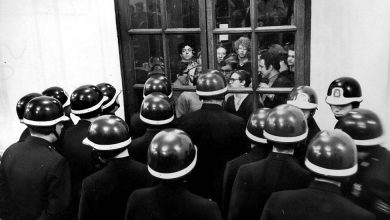Multilayered Paintings That Pay Tribute to Hip-Hop Dances

Last year, Troy Lamarr Chew II spent countless hours in the studio. If he weren’t an artist, though, he might be a linguist, a semiotics professor or a rapper. Or at least that’s the sense you get after spending time with his “Slanguage” paintings, which are imbued with messages that aren’t immediately apparent, and that often require knowledge of wordplay to decode. The series began, in 2019, as a shout-out to regional slang from Oakland, Calif., and the rest of the Bay Area. Take “Yay Area” (2020), a realist composition that brings together recognizable and mundane food items: a Coca-Cola bottle turned on its side, a chocolate layer cake atop a pedestal and a glass bowl filled with scoops of vanilla ice cream. At first glance, the still life, which recalls the work of the American painter Wayne Thiebaud, impresses with its skill and precision and evokes nostalgia for sugary childhood treats. Depending on your familiarity with certain hip-hop lyrics, though, it may later occur to you that the artist has depicted foods whose names, like the “Yay” of the title, are slang for cocaine (coke, cola, cake), and one that references the Oakland artist Dru Down’s 1993 song “Ice Cream Man,” its title an allusion to a drug dealer (though he’s hardly the only rapper to have used the term). Another work of Chew’s, “Ball Street Journal” (2020), includes images of cheese, bread and paper — all terms for money.
Partly, Chew, 29, creates his pictorial riddles simply because he can. It’s as though he’s a slick lyricist spitting lines onto his canvas, rewarding the close viewer, like the listener of a rich track played on repeat, with new layers of meaning. But Chew is also interested in centering Black language and experience, in highlighting the extent to which Black culture has shaped American culture at large and in exposingand scrambling people’s assumptions. Working in a fine art context, he is pushing against various forms of exclusion that have long reigned in that space.
Chew’s latest paintings, an extension of “Slanguage,” make up “The Roof is on Fire,” his debut solo exhibition at Altman Siegel gallery in San Francisco (on view through Feb. 19), and take on the mimetic dances hip-hop has spawned. In “Made in America” (2021), Bart Simpson wreaks havoc in a harshly litsupermarket with seemingly unending aisles; in his cart is a box of instant mashed potatoes and a bottle of Heinz ketchup. It all seems a lighthearted critique of overabundance. But present in the scene, too, are nods to three dances: the Bart Simpson, for which the dancer moves her arms across her body and then into a goal-post position as she slides from side to side; the Mashed Potato, which has her twist her feet in and out while standing on a slight tiptoe, then kick out her heels, and can be traced back to the song “Mashed Potato Time,” first performed by Dee Dee Sharp in 1962; and the Ketchup Dance, which was popularized by the Spanish pop group Las Ketchup around 2002and starts with horizontal chopping motions made with the hands. Last is the Shopping Cart, that self-explanatory classic whereby the dancer mimes pushing a cart to a beat, grabbing supermarket items and throwing them in.
Another work on view, “Ask ya Mama” (2021), shows Roger Rabbit lounging in a cabbage patch. Behind him, peeking over a leaf, is a smirking Smurf. Here, the artist is referencing the Roger Rabbit, a move that has the dancer skip backward in place while pumping her arms and chest; the Cabbage Patch, for which she looks to be stirring an invisible, chest-high pot; and the Smurf, for which she bounces at the knees while moving a bent arm diagonally across the body. In “Soulja boy tol’ Em” (2021), Clark Kent reads a copy of Vogue whose cover pictures the rapper Soulja Boy, who, in his song “Crank That” (2007), directs the dancer to “punch then crank back three times from left to right” and fly like Superman. It’s a clever scene that shows a tired cultural figure depending on a rapper for renewed inspiration and relevance. And to all this Chew has added another layer still. If you download the app Halo AR, follow the artist at tchew2 and then hold your phone in front of any of the paintings (or in front of the photos of them published here), holograms of his friends and family members, some of them professional dancers, will pop up and perform each dance.
Chew did a lot of research for the works, consulting friends, other artists and the internet. Still, hip-hop was familiar territory to him long before his “Slanguage” days. He grew up in Hawthorne, Calif., which is part of Los Angeles County’s South Bay. “It’s where the Beach Boys are from, but it’s also close to the hood, to Inglewood and Compton, so it has a little bit of both worlds,” says Chew. It’s where he first came to know West Coast groups like Digital Underground and MC Hammer (both of whom you’ll find in Chew’s new paintings if you know where to look). As a child, Chew would often sketch while rap music videos played in the background, and he describes his early art as fan art because he was often drawing the people on the screen. He still has his old sketchbooks — the beginnings of a life spent archiving the culture, as he sees it. The other art form that he gravitated toward was dance. At his middle school, dance battles weren’t uncommon, and he performed for a number of his teen years with the Y Troop, a competitive hip-hop dance group based out of his local community center. In the end, though, Chew chose art, which only occurred to him as an option when he was voted “best artist” by his high school class. “I was somebody’s best,” he says, “so I kept going.”
In college, he majored in psychology but kept sketching, watched instructional art videos on YouTube and took a few studio classes, in which he learned basics like the differences between acrylic and oil paint. “Before, I was just mixing everything I had so I could get a certain color,” he says. Eventually, he applied to the MFA programs at six schools and was rejected by all of them. But he continued to hone his skills and began adding conceptual elements to his compositions. “Pockets” (2015), a still life of all the items (a pencil, lip balm, rolling papers) inside his pockets at the time he started painting it, dates from this period. The following year, he reapplied to the same schools, and this time he got into all six. Chew graduated from San Francisco’s California College for the Arts in 2019. Along the way, he solidified his aim of honoring the legacy of the African diaspora, and co-founded the 5/5 collective, a multimedia group dedicated to making and curating work that explores Blackness.
The paintings that make up “The Roof is on Fire” continue in this vein. In the first months of lockdown, Chew was completing an artist residency at the Headlands Center for the Arts in Sausalito. “[The pandemic] didn’t feel real then, not like it would later. We were bumping music all the time, chilling,” he says. Once he left that safe communal environment, however, the gravity of the situation sunk in, and Chew greatly missed the feeling of losing himself in movement with another or with an entire crowd. In place of that, there was TikTok, a paltry substitute. And it wasn’t lost on Chew that most of the moves popular on TikTok were created by young Black dancers and then appropriated by white ones.
Once he’d decided to explore specific dances on the canvas, he made a point of including, along with some current crazes like the Renegade, created by Jalaiah Harmon, and the Savage, created by Keara “Keke” Wilson, older moves that have yet to be co-opted by the cyberspace mainstream: dances like the Tootsie Roll, which dates to the 69 Boys’ 1993 track of the same name, and the Milly Rock, named in a 2011 song by Terrance “2 Milly” Ferguson. Also included in Chew’s mix are, to name just a few more, the Mop, the SpongeBob, the Whip, the Humpty, the Hammer Time, the Chicken Noodle Soup, the Robot, the Butterfly, the Tom & Jerry, the Snake and the Sprinkler.
Chew is unconcerned that the paintings take time and effort to figure out. “Once I got to grad school, I stopped spelling stuff out so much,” he says. “If you really want to know, you’ll go search for it.” He continues, “That’s what I noticed about fine art, or art that is memorable. It just is what it is and if you want to know more, you go and do that.” In other words, if you know, you know. And Chew will continue figuring things out for himself, too — he plans to explore vernacular from other parts of California and, eventually, other parts of the country. “I always refer to myself as a kind of rapper in my head, because I’m playing with words,” he says. “Rappers are like Picasso with their words. I feel like I’m the reverse: I’m Jay-Z with a paintbrush.”



